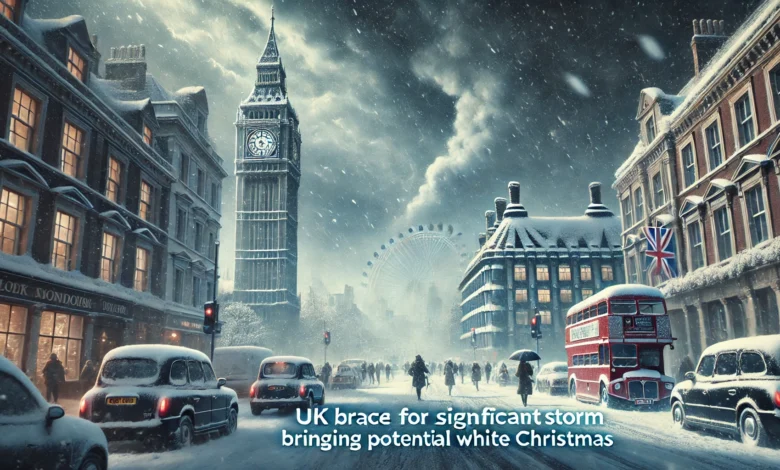UK Braced for Significant Snowstorm Bringing Potential White Christmas

As the holiday season approaches, the United Kingdom is bracing itself for what meteorologists are calling a significant snowstorm, potentially culminating in a white Christmas for large parts of the country. A rare convergence of meteorological conditions is set to plunge the nation into freezing temperatures, heavy snowfall, and treacherous travel conditions—ushering in a wintry spectacle reminiscent of classic festive scenes.
From the Scottish Highlands to the southern reaches of England, snow warnings are being issued, with models suggesting a powerful Arctic blast could transform the landscape into a snow-covered wonderland. While such events are relatively rare in recent UK winters, the forecast has ignited excitement and concern in equal measure.
A Rare Wintry Forecast: Why This Snowstorm Is Different
Britain is no stranger to erratic weather patterns, but the upcoming snowstorm—predicted to hit in mid to late December—stands out due to its breadth, intensity, and timing. According to the Met Office and independent forecasters, a deep polar vortex is descending from the Arctic, bringing with it a cocktail of freezing temperatures, gale-force winds, and heavy snow.
This weather system is fueled by a sudden stratospheric warming (SSW) event, which can disrupt the jet stream and allow frigid Arctic air to spill southward over Europe. When this air mass clashes with moist Atlantic systems, the result is often heavy snowfall—sometimes enough to grind travel and commerce to a halt.
Simon Partridge, a senior meteorologist with the Met Office, noted:
“This is shaping up to be one of the most notable snow events we’ve seen in recent years, particularly given its potential impact across much of the UK and its alignment with the Christmas period.”
Timeline of the Incoming Storm
Meteorological models suggest the snowstorm will begin developing around December 18–20, initially impacting northern Scotland and gradually moving southward.
- December 18–20: Light snow showers expected across the Scottish Highlands and northern England. Cold air begins to establish itself over the UK.
- December 21–23: More widespread snowfall anticipated. Central and southern England, including Greater London, could see several inches of snow.
- Christmas Eve – December 24: The storm reaches its peak. Blizzards may occur in some regions, with snow accumulations reaching up to 15 cm in lowland areas and over 30 cm in higher elevations.
- Christmas Day – December 25: High chance of a white Christmas in major cities including Birmingham, Manchester, and possibly London.
The Chances of a White Christmas
The term “white Christmas” in the UK is officially defined as one snowflake observed falling during the 24 hours of December 25. Based on this criterion, forecasters are giving a 60-80% probability of a white Christmas for large swathes of the country, especially north of the Midlands.
Historically, truly snowy Christmases have become rarer in the UK due to global warming and milder winters. However, 2025 could buck this trend. Meteorological data and analog years show similar patterns producing snow on Christmas in 2010, 1995, and 1981.
Regional Impacts: From Scotland to the South Coast
Scotland
Scotland is expected to bear the brunt of the early snow, with blizzards predicted in the Highlands and Grampians. Aberdeen and Inverness may see travel severely affected, while rural communities could experience power outages due to wind-driven snow and ice buildup on power lines.
Northern England
Cities like Newcastle, Leeds, and Sheffield are likely to receive consistent snowfall throughout the week leading to Christmas. The Pennines and Lake District will see significant snowdrifts, potentially leading to road closures and school disruptions.
The Midlands and Wales
The Midlands, often a weather boundary, will likely experience moderate to heavy snow, especially around Birmingham, Nottingham, and Stoke-on-Trent. South Wales could see a mix of snow and sleet initially, turning to snow as the system deepens.
Southern England
London, which rarely sees a white Christmas, has a fair chance this year. Forecast models show temperatures dipping well below freezing by Christmas Eve, with snow showers developing. Counties like Kent, Sussex, and Hampshire may wake up to snow-covered rooftops and quiet, icy streets.
Travel Disruptions Expected Nationwide
The UK’s transportation infrastructure is vulnerable to severe winter weather. The Department for Transport has issued early warnings to road and rail operators to prepare for significant delays and disruptions. The AA and RAC are advising motorists to avoid unnecessary travel during the storm’s peak.
Air travel may also be affected. Heathrow, Gatwick, and Manchester airports are implementing contingency plans including de-icing teams, revised schedules, and extended runway inspections.
Transport Secretary Lucy Fraser said:
“We’re working closely with transport providers to minimize disruption. Safety is our top priority, and we encourage the public to plan ahead.”
Supermarkets and Supply Chains on Alert
Retailers and supply chain managers are taking steps to ensure the snowstorm doesn’t disrupt Christmas deliveries. In recent winters, snow has caused shortages in essential items such as bread, milk, and heating oil, as trucks struggled to navigate frozen roads.
Tesco, Sainsbury’s, and Asda have reportedly increased their fleet of winter-ready delivery vehicles and stocked up on salt and grit for depots. Online delivery windows for the week of Christmas have already seen high demand, particularly in rural areas.
Public Safety Measures and Emergency Preparations
The government and local councils are preparing emergency response plans. Gritting teams are on standby, and extra shelters are being opened for vulnerable populations, including the homeless and elderly.
The UK Health Security Agency has issued a Level 3 Cold Weather Alert, warning of increased risks from hypothermia and respiratory illnesses. Citizens are encouraged to check on elderly neighbors, stock up on essentials, and keep homes warm.
Dr. Agostinho Sousa of the UKHSA warned:
“Extended exposure to cold weather can be life-threatening, particularly for the elderly and those with underlying conditions. Simple measures like ensuring your home is heated to at least 18°C can save lives.”
Economic and Environmental Implications
While picturesque, heavy snowstorms come at a high economic cost. Analysts estimate that if the snowstorm disrupts just three days of commerce, the UK economy could lose up to £2 billion in lost productivity, transport delays, and emergency services.
On the environmental side, the snowstorm may have a temporary positive impact. Cold spells can reduce air pollution levels, particularly in urban areas, as traffic and industrial activity slow. However, increased energy usage to heat homes could offset these gains.
Christmas Cheer: The Bright Side of Snow
For many, the prospect of a snow-covered Christmas brings nostalgia and joy. Children building snowmen, families gathering around fires, and festive films taking on new meaning with real snow outside the window.
Travel agencies have also seen a surge in last-minute winter holiday bookings within the UK, with ski resorts in Scotland and snow-capped countryside cottages gaining popularity.
Retailers are capitalizing on the forecast by ramping up marketing for snow gear, sleds, and warm apparel. Local councils are even organizing community snowman-building contests and festive sled races.
Climate Change and Extreme Weather: Is This the New Normal?
While a snowy Christmas may seem like a return to traditional winters, scientists caution against interpreting individual weather events as signs of long-term climate trends. Climate change can lead to greater variability, increasing the risk of both mild winters and extreme cold spells.
Dr. Helen Czerski, a climate physicist, explained:
“Global warming doesn’t eliminate snow. In fact, a warmer atmosphere holds more moisture, which can result in heavier snow under the right conditions. What we’re seeing is climate change amplifying the extremes.”
What to Expect After Christmas?
The snowstorm may not end on Christmas Day. Some models show cold conditions lingering into the New Year, with additional snowfall possible through early January. This could affect New Year celebrations, return-to-work commutes, and school reopenings.
The Met Office advises Britons to monitor official weather warnings via its website and the National Severe Weather Warning Service (NSWWS).
Conclusion: A Snowy Season to Remember?
With forecasts aligning for a memorable winter event, the UK stands on the brink of a significant snowstorm that may turn Christmas 2025 into a storybook scene. While the beauty and romance of a white Christmas are undeniable, so too are the risks and logistical challenges that come with it.
From the twinkling lights reflecting off snowy rooftops to the crunch of boots on icy pavements, the coming weeks may bring a rare opportunity to enjoy a festive season straight out of a Christmas card. Whether you’re hunkering down by the fire or donning thermals for snowball fights, one thing is clear: this December will be one to watch—and remember.



